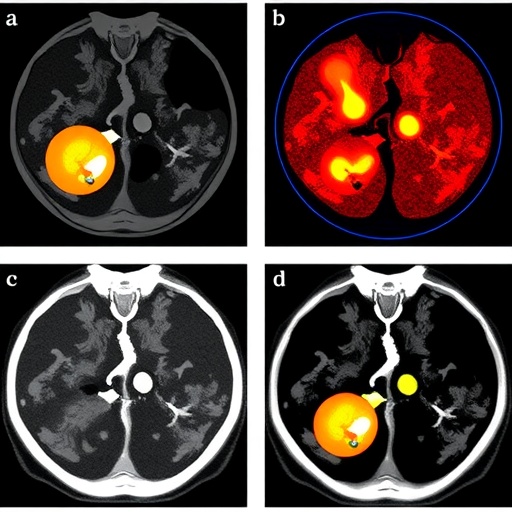
In a groundbreaking advancement for prostate cancer diagnosis, researchers have developed an innovative ultrasound molecular imaging technique aimed explicitly at the early detection of castration-resistant prostate cancer (CRPC). This new approach leverages the unique properties of microbubbles modified with Neuropilin-2 (NRP2), a protein increasingly expressed on endothelial cells during prostate cancer progression. Prostate cancer remains one of the most common male malignancies worldwide, and the transition to CRPC marks a particularly aggressive phase of the disease with drastically reduced survival rates, underscoring the critical need for earlier and more precise diagnostics.
Traditional prostate-specific antigen (PSA) testing, the standard diagnostic tool for prostate cancer, suffers from notable drawbacks such as delayed detection and limited specificity, often leading to diagnostic uncertainty and delayed treatment interventions. The new study, recently published in BMC Cancer, proposes that molecular imaging using NRP2-targeted microbubbles (MBs_NRP2) could fill this crucial gap, enabling clinicians to visualize and quantify disease progression with unprecedented accuracy and speed.
Central to the researchers’ strategy is the identification and targeting of NRP2, a receptor prominently upregulated on endothelial cells within tumor-associated neovasculature during prostate cancer evolution. Utilizing sophisticated immunofluorescence techniques, the team confirmed a strong colocalization of NRP2 with CD31, an established endothelial marker, in prostate cancer tissue samples. This finding provided a robust biological foundation for the development of their innovative imaging agents.
Building upon this discovery, the scientists engineered microbubbles conjugated specifically to NRP2 to enhance their selective binding to tumor microvasculature. These microbubbles, when administered systemically, demonstrated remarkable precision in adhering to endothelial cells expressing NRP2, a phenomenon verified under dynamic flow conditions using parallel plate flow chamber experiments. This dynamic validation underscores the clinical relevance of MBs_NRP2 in mimicking physiological blood flow environments.
The researchers further explored the biological interplay between prostate cancer cells and endothelial cells through intricate co-culture systems replicating the tumor microenvironment. Analysis of these co-cultures revealed that as prostate cancer advances toward a castration-resistant state, endothelial cells exhibit a progressive increase in NRP2 expression. This escalation correlates with enhanced angiogenic activity, potentially driving the aggressive neovascularization characteristic of advanced prostate tumors.
To elucidate these cellular dynamics, the team employed a multi-modal analytical framework comprising immunofluorescence localization, flow cytometry, western blotting, and angiogenesis assays. This comprehensive approach offered detailed insights into how NRP2 expression varies alongside tumor progression and vascular remodeling, solidifying its role as a compelling molecular target for diagnostic imaging.
The pinnacle of this research involved applying ultrasound molecular imaging (USMI) in mouse models bearing subcutaneous prostate tumors at various stages: hormone-sensitive prostate cancer (HSPC), non-metastatic castration-resistant prostate cancer (nmCRPC), and metastatic castration-resistant prostate cancer (mCRPC). Quantitative analysis of contrast-enhanced ultrasound signals revealed significantly heightened imaging intensities in tumor-bearing mice compared to controls, with progressive increases correlating to more advanced disease stages.
These results suggest that MBs_NRP2-based USMI may serve as a sensitive biomarker for not only detecting the presence of prostate cancer but also stratifying its severity and resistance to hormonal therapy. Such stratification is pivotal in guiding personalized therapeutic decisions and improving patient outcomes, especially considering the poor prognosis associated with CRPC.
Another remarkable aspect of this technology is its non-invasive nature and real-time imaging capability. Unlike conventional diagnostic tests prone to false positives or lengthy procedural delays, ultrasound molecular imaging offers a rapid, safe, and repeatable method to monitor molecular changes in tumor vasculature over time, potentially enabling clinicians to detect resistance emergence earlier and adjust treatment regimens proactively.
The development of MBs_NRP2 showcases the increasing convergence of molecular biology, bioengineering, and clinical imaging. By harnessing specific molecular targets like NRP2 on neovascular endothelial cells, researchers can design contrast agents that provide functional insights rather than solely anatomical information, revolutionizing cancer diagnostics.
Looking ahead, the translation of this promising preclinical work into clinical settings poses exciting opportunities and challenges. Scaling the production of NRP2-targeted microbubbles, regulatory approvals, and validation through large-scale clinical trials will be essential milestones toward establishing this technique as a routine tool in prostate cancer management.
Moreover, this research opens avenues for exploring similar molecular imaging strategies targeting other cancer types characterized by aberrant angiogenesis and receptor expression. The modular nature of microbubble design allows for adaptation to various molecular targets, positioning ultrasound molecular imaging at the forefront of precision oncology diagnostics.
The implications of early and accurate CRPC diagnosis are profound. CRPC is notoriously difficult to treat, often demonstrating resistance to conventional androgen deprivation therapies. Early detection through advanced imaging could drastically alter the clinical course by enabling timely intervention, potentially improving survival rates and quality of life for thousands of patients worldwide.
In sum, the MBs_NRP2-based ultrasound molecular imaging platform represents a significant leap forward in cancer imaging technology. It transcends current diagnostic limitations by providing a sensitive, specific, and dynamic visualization method for prostate cancer neovascularization, particularly during the critical transition to castration resistance.
As the field of molecular imaging continues to evolve, innovations like these not only enhance our diagnostic arsenal but also deepen our understanding of tumor biology and progression. They epitomize an era where interdisciplinary efforts yield transformative clinical tools, bringing hope to patients facing some of the most challenging cancers.
This pioneering research underscores the vast potential of targeted ultrasound contrast agents and sets the stage for future studies aimed at refining molecular diagnostics and ultimately improving patient care pathways within oncology.
Subject of Research:
Article Title: MBs_NRP2-based ultrasound molecular imaging for early diagnosis of castration-resistant prostate cancer
Article References:
Wang, N., Xu, X., Zhong, Y. et al. MBs_NRP2-based ultrasound molecular imaging for early diagnosis of castration-resistant prostate cancer. BMC Cancer 25, 769 (2025). https://doi.org/10.1186/s12885-025-14143-7
Image Credits: Scienmag.com
DOI: https://doi.org/10.1186/s12885-025-14143-7
Tags: advanced prostate cancer diagnosticsearly detection of castration-resistant prostate cancerendothelial cells in cancer progressionimmunofluorescence techniquesinnovative cancer imaging technologiesNRP2-targeted microbubblesprecision medicine in oncologyprostate cancer diagnosisprostate-specific antigen limitationssurvival rates in prostate cancertumor-associated neovasculatureultrasound molecular imaging technique





